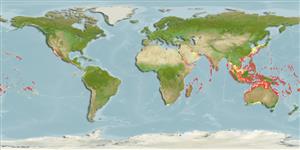Common names from other countries
Environment: milieu / climate zone / depth range / distribution range
Écologie
marin; saumâtre récifal; profondeur 0 - 10 m (Ref. 86942), usually 0 - 10 m (Ref. 37816). Tropical; 40°N - 40°S
Indo-Pacific: East Africa to the Hawaiian, Marquesan, and Mangaréva islands, north to southern Japan, south to northern New South Wales, Australia. Also recorded from Southeast Atlantic: South Africa (Ref. 3972).
Taille / Poids / Âge
Maturity: Lm ? range ? - ? cm
Max length : 66.0 cm TL mâle / non sexé; (Ref. 1602)
Description synthétique
Clés d'identification | Morphologie | Morphométrie
Épines dorsales (Total) : 0; Rayons mous dorsaux (Total) : 0; Épines anales: 0; Rayons mous anaux: 0; Vertèbres: 162 - 171. White to yellow with 25-30 black saddles (Ref. 3972).
Occurs in sandy areas and seagrass beds of both lagoon and seaward reefs. Uses its stiff pointed tail to rapidly burrow backwards into the sand when frightened (Ref. 37816). Benthic (Ref. 58302). Feeds on sand-dwelling fishes and crabs and prawns. Sometimes fully exposed when searching for prey (Ref. 30874). Rises to the surface to spawn (Ref. 37816).
Life cycle and mating behavior
Maturities | Reproduction | Spawnings | Egg(s) | Fecundities | Larves
Rises to the surface to spawn. Once there, one or more males may seize a female by the back of the neck and remain attached for hours before spawning occurs.
Myers, R.F., 1991. Micronesian reef fishes. Second Ed. Coral Graphics, Barrigada, Guam. 298 p. (Ref. 1602)
Statut dans la liste rouge de l'IUCN (Ref. 130435)
CITES (Ref. 128078)
Not Evaluated
Menace pour l'homme
Harmless
Utilisations par l'homme
Outils
Articles particuliers
Télécharger en XML
Sources Internet
Estimates based on models
Preferred temperature (Ref.
115969): 24.4 - 29.2, mean 28.1 (based on 2893 cells).
Phylogenetic diversity index (Ref.
82804): PD
50 = 0.7500 [Uniqueness, from 0.5 = low to 2.0 = high].
Bayesian length-weight: a=0.00089 (0.00039 - 0.00204), b=3.00 (2.80 - 3.20), in cm Total Length, based on LWR estimates for this (Sub)family-body shape (Ref.
93245).
Niveau trophique (Ref.
69278): 3.1 ±0.3 se; based on diet studies.
Résilience (Ref.
120179): Milieu, temps minimum de doublement de population : 1,4 à 4,4 années (Preliminary K or Fecundity.).
Fishing Vulnerability (Ref.
59153): Moderate to high vulnerability (46 of 100).
